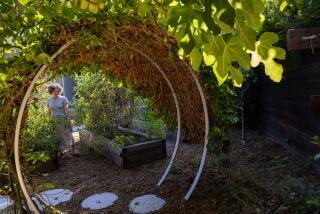A patchy lawn in Tustin is reborn as a year-round, native garden
- Share via
Steve and Anita Widmayer wanted to update the landscaping of their Tustin home, likely unchanged since it was built in the 1970s — a patchy lawn thirsty for water, a bland sidewalk leading from the driveway, ho-hum hedges.
“You pull into the driveway, get into the house, you never see anybody,” Steve Widmayer said of their home of 24 years. “We wanted to make it more inviting.”
At first they considered an English garden — lots of flowers, a picket fence. But soon they realized how much water and work that would take to maintain. They began exploring water-wise gardening by doing research, attending home and garden tours in that style and visiting native-plant nurseries.
They knew they didn’t want California natives that looked great in the spring but went dormant in the dry summer.
The couple realized they needed the help of a landscape architect and scrutinized bids. (One reject had only the barest description — “demo, install plants, install lighting, patio cover + irrigation.” But Widmayer, a civil engineer, knew that having a detailed contract and a deeply itemized plan would avoid problems mid-project. “You’re not going to get what you want if you just have an open checkbook,” he said.)
They ultimately enlisted Laurie Martz, an Orange County-based registered landscape architect, to help them find the right placement and mix of evergreens, flowering natives and other specimens to best balance water and maintenance needs with year-round aesthetics.
Their main goal was to turn the yard into living space. They created a new front patio and arbor, where they can sip morning coffee or entertain friends in the evening, greet passersby, or simply watch the garden and its seasonal changes. “It’s just a pleasure to be out there and watch the birds do their little things,” Widmayer said.
They swapped the turf for feather grass and sedge, and added lavender, yarrow, cranesbill geranium, Pacific coast iris, and numerous varieties of sage and succulents.
The yard is anchored by trees — a California live oak in the center, along with a Meyer lemon tree, a Golden Nugget tangerine and a pomegranate he said has “done gangbusters.”
The fruit trees add to the new garden’s bonhomie, as the Widmayers share the harvest with neighbors.
Widmayer estimates the total project cost to be about $45,000, including $2,000 to remove the driveway, walkway and existing plants, $10,000 for new plants, $4,000 for irrigation, $8,000 for concrete work and $6,000 for a patio cover, for which they requested extra-large timbers to convey heft. They installed landscape lighting, all-new drip irrigation, and deep-root watering for the trees. They also added raised beds for herbs and seasonal vegetables.
“It was a long time coming to this point,” Widmayer said — about eight months, including reviewing bids, scheduling and the actual work. “But we’re very satisfied, and we’re glad we did it.
“We’ve had people who have never been on the street before, and they knock on the door — ‘How did you do this?’ That’s been really, really nice,” he said. “If you’ve got a neighborhood that hasn’t changed much and you do something exotic you can be kind of a pioneer.”
Have you ripped out the lawn, in favor of a drought tolerant garden? We want to know about it. Send “before” and “after” images taken from the same position to [email protected] and we may profile your garden in an upcoming Saturday section.
Here’s a look at some of the trees, shrubs, plants and succulents on the Widmayer property:
Trees
Citrus meyeri – Meyer lemon
Punica granatum – pomegranate
Quercus agrifolia – coast live oak
Grasses
Calamagrostis acutiflora Karl Foerster – feather reed grass
Carex divulsa – Berkeley sedge
Festuca mairei – Atlas fescue
Leymus condensatus “Canyon Prince” – dwarf Canyon Prince wild rye
Stipa tenuissima – Mexican feather grass
Shrubs, perennials and groundcovers
Achillea millefolium – yarrow
Anisodontea “Elegant Lady” – cape mallow
Arctostaphylos “John Dourley” – manzanita
Erigeron “Wayne Roderick” – California aster
Calylophus – sundrops
Fragaria californica – beach strawberry
Gaura lindheimeri – white gaura
Geranium sanguineum – cranesbill
Heuchera “Wendy” – coral bells
Iris PCH “Lavender” – Pacific Coast hybrid iris
Nepeta faassenii — catmint
Penstemon — “Midnight”
Perovskia atriplicifolia – Russian sage
Ribes sanguineum glutinosum – pink flowering currant
Salvia clevelandii – Cleveland sage
Salvia “May Night” – dwarf sage
Salvia chamaedryoides – electric blue sage
Salvia “Waverly” – Waverly sage
Verbena bonariensis – tall verbena
Succulents
Calandrina grandiflora – “Jazz Time” jade
Echeveria imbricata – hen and chicks
Agave “Blue Flame” – dwarf agave
Aloe striata – hybrid coral aloe
Euphorbia rigida – spurge
Lavandula intermedia “Provence” – Provence lavender






